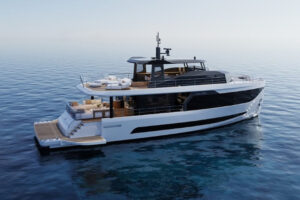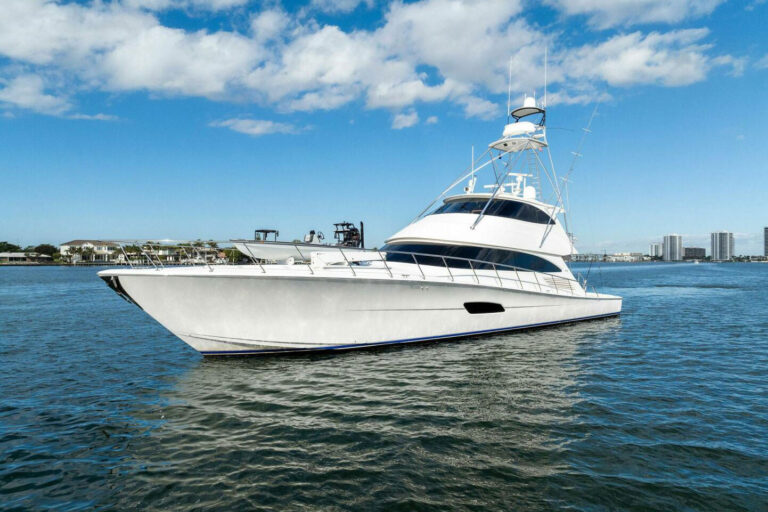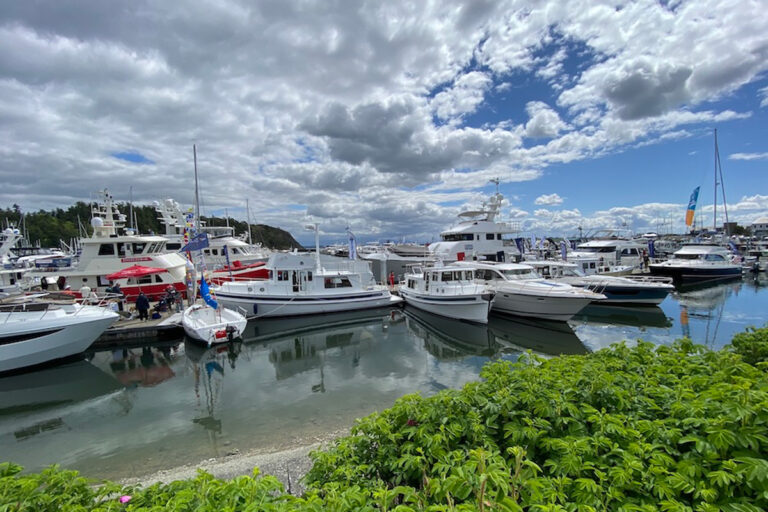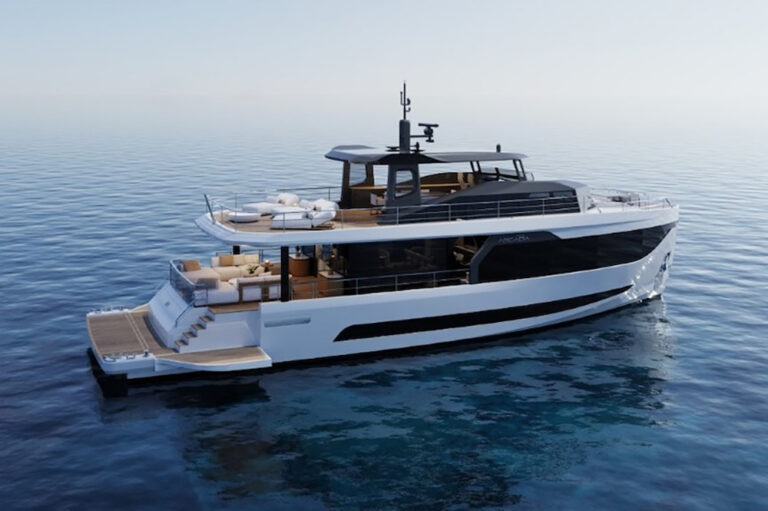
Princess 64 Main
I need to be very clear about this. I am an Anglophile. I love the Brits, I love their warm beer and kidney pie, I love their cheerful cabbies and helpful bobbies, and I even love their often-soggy weather. And I love their boats.
The Princess 64 is no exception. This model is like a breath of fresh air on a spring day in the English countryside. Although the Princess 64 is decidedly Euro in her swoops and curves, drawing her DNA more from Sophia Loren than from Margaret Thatcher, she is a lovely yacht and she will draw admiring looks whether the marina is in Ipswich or Block Island, Dubai or San Diego.
The Brits also know how to build boats. It’s not just that there was a time when the sun never set on The Empire or that the Royal Navy once ruled the waves; it’s more about being an island nation, surrounded by truly rough water. The English Channel has such appalling conditions that it kept invaders at bay for centuries, even though they could clearly see the white cliffs of Dover. The North Sea? Just another synonym for nasty. Same for the Irish Sea.
So British boats are built long on strong, and the Princess 64 is as tough as nails under that silken exterior. Cleats, thoughtfully positioned handrails and the all-important lifeline stanchions are bolted through solid backing plates so there is never a question of strength.
Anti-slip surfaces are excellent, but the Princess folks, true Brits at heart, know that a planked teak deck gives sure footing whether you’re handling dock lines on a rainy day or fighting at the Battle of Trafalgar. So standard equipment on the Princess 64 includes a teak cockpit sole, teak on the bridge, teak on the swim platform and teak steps to the bridge and side decks. And this isn’t just the usual skimpy teak veneer, but solid planks that will take all the abuse you can dish out.
_View a complete photo gallery here._
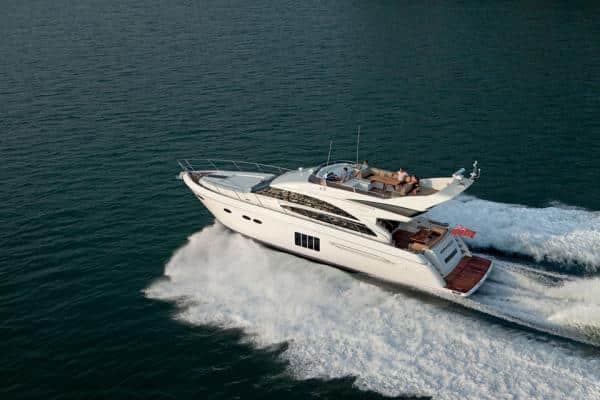
Horatio Nelson’s flagship was wood, of course, but that hasn’t stopped Princess from embracing modern technology with full push-pull resin infusion throughout the 64 — including not just the hull and deck, but also the deck hatches, inner liners and all other ancillary parts. It also does something very smart: Clear gelcoat is used below the waterline so that any voids or flaws can be seen as soon as the hull pops out of the mold. Clear gelcoat also makes it much easier if repairs are needed, since any damage is visible. Above the waterline, Princess uses PVC coring for strength and insulation from both temperature and sound.
So is the Princess 64 a new design? Well, sort of. She is, in fact, an evolution from the Princess 63, but it’s a bit confusing because the 63 was actually 62 feet 6 inches, while the new 64 is 64 feet 10 inches, or 2 feet 4 inches longer. The supposed length in the title doesn’t reflect the gains made with the 64, which has a much larger cockpit with enough room for a wraparound settee rather than the usual bench seat against the transom.
Both hulls (and, in fact, the entire Princess line) were designed by Bernard Olesinski, and they have a comfortable, solid and reassuring seaworthiness under way. Double strakes and a hard chine that rises above the waterline at the bow soften the ride in those square-edge seas of the English Channel, and they also roll the water out to the side rather than back in your face.
Standard equipment includes a hydraulic/electric swim platform that serves as the tender storage and launching system, which eliminates the need for either a bulky davit or a transom garage, which would take up interior room. (One owner is planning to put a 12-foot Boston Whaler on the platform, which gives you an idea of the space available.) And, with the tender launched, the platform makes a delightful semisubmerged “beach” for swimming.
The cockpit, as I mentioned, benefits from the additional length with a full lounge, but before I get to the fluffy interior, I have to admire the crew cabin. With no tender garage, there is room for a truly civilized two-berth crew cabin complete with — get this — an en suite head with shower stall. This isn’t the usual European crew cabin that would make solitary confinement at Alcatraz seem appealing, but a comfy getaway with an entry that doesn’t make everyone move off the settee. Since the 64 would be a breeze for a couple to handle, the crew cabin would, I think, be perfect for a couple of teenagers who can play video games and loud music without disturbing anyone.
Triple-frame sliding doors open the interior to the cockpit, and you must notice that this is essentially a one-level living area: The salon incorporates the entertainment area, dining table, galley and lower helm in one seamless space. A pop-up TV is aft, facing a U-shape lounge with cocktail table, surrounded by the black cherry joinery on our test 64, though oak and walnut are also available. The finish was satin rather than the usual high-gloss finish found on many imported yachts, making it very easy to flawlessly touch up.
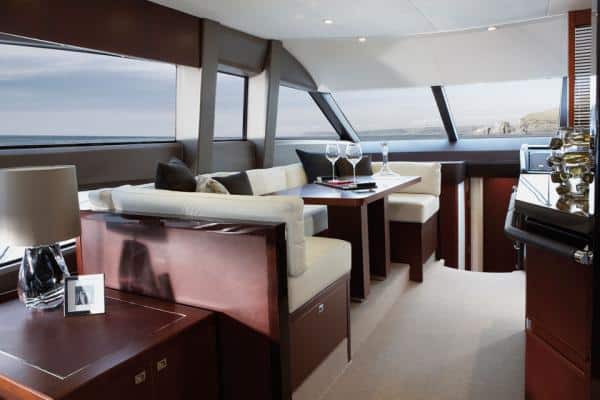
The galley is open (sliders can partition it on the after side) and pleasant, with a stand-up Waeco refrigerator, oversize self-closing drawers and a dedicated crockery drawer perfectly fitted for the set of Princess china dinnerware. One thing that you quickly notice if you poke around a bit on the 64 is that Princess does a superb job of using every bit of space to create useful stowage: under the settees, beneath counters, even under the cocktail table.
The dinette comfortably seats eight, which I mention because so many manufacturers forget how many berths they have when creating the dinette. In this case, a pair of stools that store neatly under the forward berth provide all the extra seating needed.
The lower helm clearly comes from the nation that brings us the Aston Martin, with a pair of superbly upholstered leather bucket seats and a dashboard that is easy to scan. Standard electronics are a full Simrad package, including radar, chart plotter and GPS, although our test boat had been fitted with Furuno as an owner’s option.
At the skipper’s elbow is a door to the side deck, adding to the ease of handling the 64 short-handed. But wait! This isn’t just your usual pantograph door. First, it’s made of carbon fiber so it’s really light, and second, it closes with an electric lock, making the kind of whooshy noise I imagine astronauts hear as they are sealed into their capsule. Way cool.
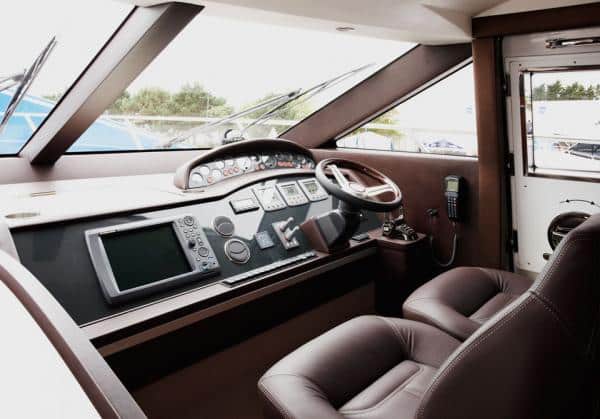
I also have to note that the line of sight from the lower helm is exceptional. Because of the open nature of the salon, the skipper has only a teensy blind spot right behind his head (the fridge), but even the sight lines to the corner of the stern are good.
The staterooms are everything you’d expect from a boatbuilder owned by Louis Vuitton Moet Hennessy. No, there’s no Vuitton pattern on the seats and not a champagne bucket in sight, but it’s pure luxe throughout. Just getting to the cabins is an experience, from the gentle stairs with an atrium effect overhead to the rails wrapped in exquisite stitched leather.
The master stateroom spans the full beam amidships, with a stylish padded headboard for the king-size centerline berth and huge ports that provide a view of the surroundings. A note on these ports: Rather than the usual separately fitted panes used on many yachts, Princess uses a massive single frame with its own mullions, recessed in the hull side for protection.
The master has the usual bureau, to starboard, but with a cute fillip: The vanity pulls out so the berth becomes the seat. To port is a chaise that Dr. Sigmund Freud would have loved in his office, and I give Princess great credit for hanging lockers that are full length. The master head features a teak sole and a huge shower.

Forward, the VIP stateroom also has an en suite head with a circular shower and generous stowage. In between the two staterooms are a stacked-bunk cabin to port and a double-berth cabin to starboard with private access to the day-head with shower. The two berths slide together at the touch of a button to become a double, and the mechanism is neatly hidden too.
The bridge is perfect for fine days, with a large settee (again for eight!), a wet bar/galley with barbecue, refrigerator drawers and sink, and the predictable sun pad aft. This is a British yacht, after all, so the wind protection is exceptional, with a windscreen forward and Perspex dodgers aft that don’t block the view.
The skipper and a companion inhabit two helm seats behind a fiberglass console, and a bench seat opposite seats two more guests. And as elsewhere on the Princess 64, sturdy rails provide security.
Power for our test boat was a pair of 1,150-horsepower Caterpillar C18 ACERTs, which are the most powerful of the three engine options. Smallest is a pair of 900-horsepower Volvo D13s, with the detuned 1,015-horsepower Cat C18 option in the middle.
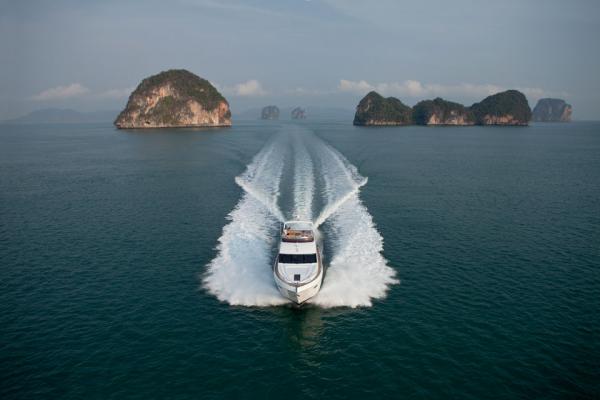
The Brits may be cutting-edge in their construction, but they have chosen to stay with conventional shaft drives rather than join the rush to pod systems, for several good reasons. First, the system doesn’t require any modifications to a well-proven hull, and second, shaft drives are easily serviced worldwide. Next, it keeps the engine weight amidships to reduce the bow angle, and last, it allows for those spacious crew quarters plus a lazarette for a generator and systems.
That doesn’t mean you lose any of the nimbleness attributed to pod drives, because Princess offers joystick controls that link the engines with the variable-speed electric bow thruster for one-handed control. Our test boat had the optional stern thruster, which links with the joystick as well, and, with the locking function, the thrusters can be used to hold the yacht against a pier while docking short-handed.
Performance of our test boat with the larger engines was surprisingly quick, which is a tribute to the light but strong construction and the slippery hull design. We topped out at nearly 34 knots, averaged on two-way runs. That’s not bad for moving some 33 tons — plus, in our case, full fuel and half water.
Steering is sports-car easy, and, depending on how often you want to visit the fuel dock, she has a cruising speed of 27 to 30 knots. Why give a spread? Because our test figures showed that she has exactly the same range (257 miles) at either 26.7 knots or 30.8 knots. Again, a tribute to a well-balanced and efficient hull.
The Princess 64 is imported by Viking Sport Cruisers, which takes the basic yacht and then greatly expands the standard equipment list. These upgraded yachts are built to Viking specifications to meet or exceed all U.S. Coast Guard, American Boat and Yacht Council and National Marine Manufacturers Association regulations and recommendations.
Among the equipment added or changed by Viking Sport Cruisers is the upgraded Cat C18 ACERT engines, the electrical system (to U.S. 120 volts/60 Hz), central vacuum, upgraded generator (to 21.5 kW), vacuum heads and a turnkey package including linens, china and cutlery.
As you can guess, I liked the Princess 64 a lot. Built tough but luxuriously fitted, fast but seaworthy, she should be on your short list at the next boat show.
_View a complete photo gallery here._
Test Conditions: Speeds were measured by GPS off Riviera Beach, Florida, with flat seas and light winds, a full load of fuel, ½ load of water and four people aboard. Fuel consumption was calculated by the electronic engine-monitoring system. Sound levels were measured at the helm.
RPM Knots GPH dB(A)
600 7.3 1.0 68
900 9.6 6.0 68
1200 11.8 23 70
1500 15.9 42 74
1800 22.2 73 76
2100 28.8 89 76
2350 33.7 114 76
LOA: 64’10”
BEAM: 16’7″
DRAFT: 4’9″
DISPL.: 66,140 lb.
FUEL: 900 gal.
WATER: 240 gal.
ENGINE OPTIONS: 2 x 900 hp Volvo Penta D13 diesels
ENGINES TESTED: 2 x 1,050 hp Cat C18 ACERT diesels
BASE PRICE: Upon request
Viking Sport Cruisers, 877-846-9874; www.princessyachts-us.com


